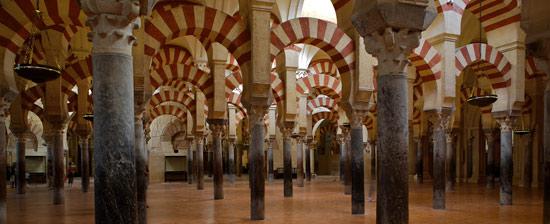
CORDOBA
The best travel guide to Cordoba: all-inclusive hotels, tours, day trips and tips
Córdoba. Situated at the foot of the Sierra de Córdoba on the North bank of a sharp bend in the Guadalquivir. A provincial capital with a very strong Moorish character, it is one of the most interesting cities not only in the region of Andalusia but also in the whole of Spain. Discover in this Cordoba guide all you need to know to prepare your trip to this fantastic city.
Indeed, Córdoba developed into one of the most magnificent cities in the western
world.
3 Top Cordoba Tours & activities
Mosque & Cathedral Group tour with priority access
Alcazar Guided Tour with Skip the line
Private tour of Patios de Cordoba
Cordoba Travel Guide - Contents
Our 3 top: hotels in Cordoba
Balcón de Córdoba – Gorgeous 4 star lodgings in the heart of Córdoba, near the famous Mezquita
Eurostars Azahar – Comfortable and attractive 4 star hotel in the historic city center of Córdoba
Las Casas de la Judería de Córdoba – Charming 4-star hotel in the heart of the historic city center of Córdoba
5 Top Reasons To Visit Cordoba
La Mezquita de Cordoba
The mosque is what brings most tourists to Cordoba and we admit it is a must-see not just in Andalusia, but in Spain. The mosque is one of Spain´s most important sights and a unique place. Before it was a mosque it was already a Visigoth place for worship, so people have been praying here for as long as records exist. The Cathedral is located inside the Mosque and this makes the building unique. Looking at the arches inside the mosque it is easy to understand that Cordoba was the largest and most important economic city in the West at the time of the Capliphate.
Flowers and Patios
Cordoba is full of houses that host amazing Patios. Many of them cannot be visited aside for a week in May when the Patios festival takes place. This local festival is one of the best things to enjoy in Spain in May. Luckily for all visitors many of the patios can be visited all year round, and some free of charge .
Gastronomy in the Jewish district
Cordoba is one of Spain´s best places to enjoy traditional taverns. Many of them are located in the old part of Cordoba and have been there for centuries. You will be able to enjoy mouth-watering local delicacies while you stroll some of the most beautiful streets of the city
Medina Azahara
unknown to many visitors to Cordoba, this old city was built in the 10th century. This is a complete urban ensemble which features roads, water systems and beautifully decorated buildings. It hidden character for centuries contributes to its mystery. This archaeological site is an excellent example of the importance of architecture for the Umayyad civilization of Al-Andalus.
Great train connections
Cordoba can even be a day tour from Madrid! The train connections with AVE make it very simple to get to Cordoba from Madrid, Seville, or since more recent times, from Granada. This should make Cordoba unavoidable! Have a look at Spain´s train map to better understand the possible combinations to visit Cordoba and other cities.
Best Time To Visit Cordoba
We would recommend you to avoid if possible July and August due to the high temperatures. This is however the only possible time of the year to visit for many people! If you visit in summer we would recommend to start your days early and if possible to book a hotel in Cordoba with pool.
We love Cordoba in May at the time of the patios Festival, but we also believe September and October are fantastic months. June and April are also great months and since it is never really cold in Cordoba, winter should be a good moment and accommodation prices are more affordable.
Weather In Cordoba
Temperatures in Cordoba during summer can range 90 F (average for daily highs). Daily lows during summer are above 60F.
From mid November till end of February daily high average temperatures are between 60 and 65F and daily low average temperatures range between 40 and 45F.
During summer it is very unlikely you will get a rainy day in Cordoba. The rainest month of the year in Cordoba is October, with the probability of having a rainy day close to 25%
Most popular attractions in Cordoba
Brief History of Cordoba
Cordoba had already been settled in Iberian times. It became capital of the province of Hispania Ulterior in AD 152 and was later again a capital, this time of the province of Baetica (Baetis was the name of the Guadalquivir), which covered approximately the same of area as present day Andalusia.
Visigoth rule began in the middle of the 6C and bequeathed a legacy of buildings. Buildings continued under the Islamic conquerors (711). The Arabs made Córdoba the centre of a great empire stretching as far as the Pyrenees. Under the Omayyad ruler Abd ar Rahman I, Córdoba became an emirate (756), and under Abdar Rahman III (912-61) a caliphate. This period was the city’s historical and influential heyday, and it continued until 1010.
There was a superb irrigation system, a population of about half a million and a blossoming economy, of which the leather industry (cordwain) was particularly famous.
The lovely Great Mosque became a centre of Arab pilgrimage. The town had a further 300 mosques, numerous palaces and equally numerous free schools, universities and public libraries, hospitals and baths. Córdoba’s cultural life was so great that it became of European importance.
The mighty caliphate ended in 1031, after which the harsh religious attitude of the Almoravide rulers destroyed many of the magnificent buildings from the Omayyad era. Decadence set in and this resulted in a gradual shift of power to Seville. The cultural life of Córdoba shone once more in the 12C with the great Islamic philosopher Averroës, who was a son of the city and who made the works of Aristotle famous
in the west. His contemporary was the notable Jewish scholar Maimonides. Arab supremacy came to an end in 1236 with the victory of the allied Christian kings in the course of the Reconquista. Ferdinand III, the Holy, conquered the town. Above all, the breakdown of the irrigation system in the fertile campiña meant economic collapse. With the end of Córdoba’s great era came the rise of Granada under the Arab Nasrite dynasty.
Under Ferdinand and Isabella, General Gonzalo Fernández de Córdoba became particularly famous. He was born near the city in 1453, and successfully fought against Moorish Granada. Later he was known as ‘El Gran Capitán’
How to spend 1 day in Cordoba?
Our 1 day in Cordoba recommendations : Cordoba was one of the most important cities in the world 1,000 years ago and a cultural super-power. During your visit, you will be able to enjoy this feeling, which remains alive in Cordoba still today. At the centerpiece, the gigantic Mosque and cathedral. This is one of the few places in the world where people can enjoy mass inside a mosque. But there is much more to enjoy in Cordoba: its narrow white streets, its famous Patios full of flowers…. We are sure you will Fall in love with Cordoba!
The Mosque
If there is one thing to enjoy in Cordoba, this is the Mosque.
During Mass you can enter free of charge. You will however not be able to visit it and the only area which you will be able to access is where the Mass takes place.
The tickets can be purchased using machines located near the entrance. You should arrive early to avoid long queues.
We strongly believe the best option to visit the Mosque is a guided tour. You avoid crowds and get guided by a local expert.
No matter how you decide to visit the mosque, we recommend you read about its history before you visit (we provide an enjoyable, reduced version of the history of the Great Mosque in this link)
Insider tip: we recommend to enjoy the views from the tower. 300 steps (with the option to stop at different levels to rest) . You wil be able to take fantastic pictures from here.
We strongly recommend you not to miss the views from the other side of the Roman bridge.
The walk from the Great Mosque to Viana Palace is full of interesting monuments, streets and squares.
Calle del pañuelo
(handkerchief alley) . This street receives this name because in its narrowest point it is no larger than an handkerchief being hold by two people that face each other
Calleja de las Flores
(Alley of the flowes) This is one of Cordoba´s most beautiful streets in Cordoba, Due to its size it often gets crowded. As its name indicates flowers hang on all the white houses in this street (most of which have been transformed into souvenir shops) Insider tip: turn your head if you arrive from the mosque to enjoy views of the tower or wait for the small square at the end of the alley.
Plaza del Potro
This square gets its name from the foal above the basin of the charming fountain. This square served as a livestock market and became famous thanks to Cervantes, who mentioned it in Don Quixote. The writer is said to have slept at the Meson del potro.
Plaza de la Corredera
When you get to this square you may think you have left Cordoba and have been transported to Castilla. There is nothing strange on this since the architect in charge was born in Salamanca. This large plaza is the only square plaza in Andalucia. It is also known as the Plaza del Mercado andwas used an an arena for bullfighting for many years.
Time for lunch?
In this are of Cordoba we recommend Ermita de la Candelabria to enjoy a relaxed traditional meal. If you prefer a tapas style lunch, we recommend bar Santa Marina, near Palacio de Viana.
Roman temple
An open air temple near the Town Hall. The building has been restored and boosts a façade decorated with impressive Corinthian columns.
Cristo de los Faroles square
This is one of our favorite squares in Cordoba. Exceptionally charming and little, this cobbled square is surrounded by white walls in front of the Capucin monastery. The square offers a genuine Andalusian atmosphere and it is most of all famous for the cross that stands at its centre. The cross is surrounded by eight wrought iron lanterns, and the marble figure of El “Cristo de los Farandoles” or Cristo de la Agonía.
-Palacio de Viana.
Medina Azahara - Best day excursion from Cordoba
Located eight kilometers South-west of Cordoba Medina Azahar is an outstanding example of the power, vision, and ambition of its founder, Abd Rahman III. Less than one-tenth of the city has been excavated and not all of this is opened to the public. The numerous buildings were spread over a large area on three terraces on the slopes of the Sierra. These buildings were defended by a double wall that was defended by towers. Construction started in 936 at the suggestion of one of Abd ar Rahman´s wives, Azahara (the flower), and was completed by 960.
The entire court and the council were transferred to Medina Azahara from Cordoba (some 1.200 people). The lower terrace had the mosque, municipal buildings, stables, and accommodation for soldiers. The middle terrace had gardens and the upper terrace had beautiful palaces.
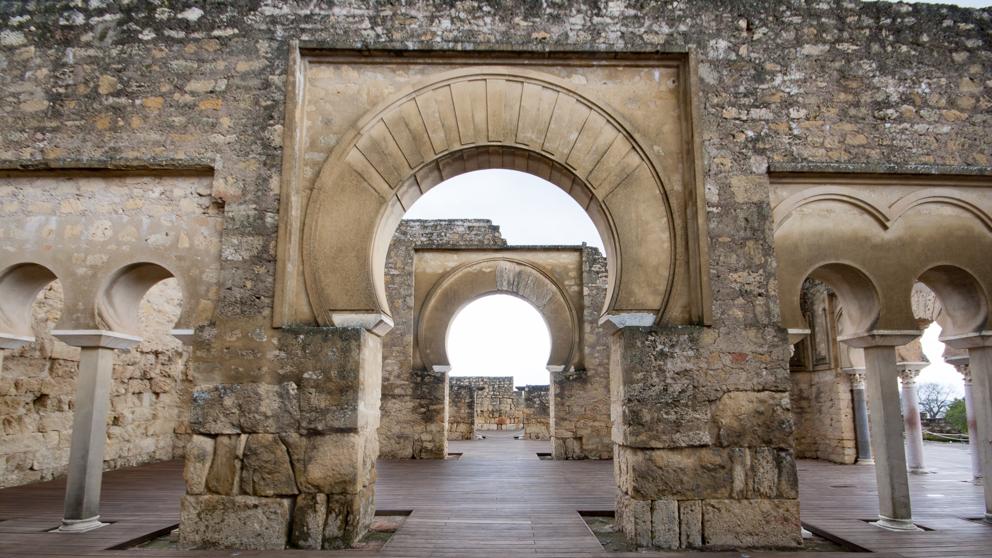
How big was Medina Azahara?
In order to get a good idea on the magnitude of the project, we can mention that 10.000 men were employed for its construction. Some 4.000 columns were used.
The irrigation system for gardens and baths was supplied by a 11-mile long aqueduct.
Why did Medina Azahara not survived?
By 1010 the court had been destroyed by the Almoravide army from Morocco. Their more strict religious attitudes were opposed to luxury.
More great Cities in Andalusia
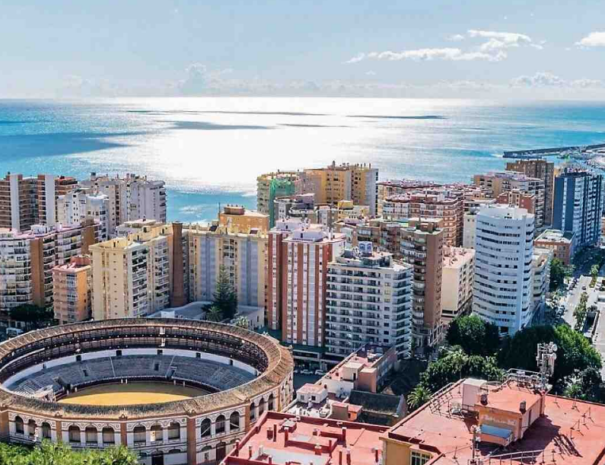
Malaga City Guide
Check out our Malaga City Guide to find all the information you will need to plan the perfect visit to this amazing city in Southern Spain … Read More
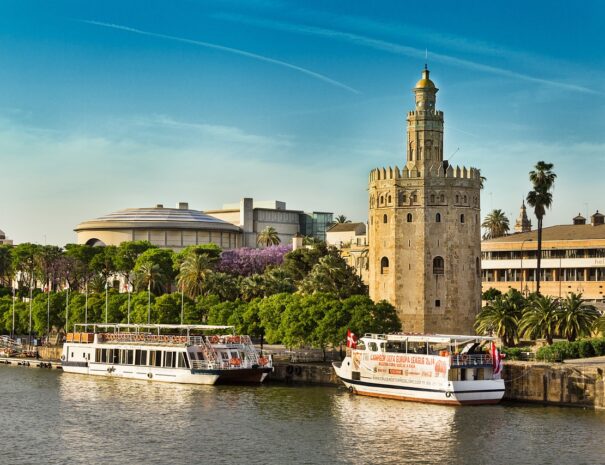
Seville City Guide
“Sevilla tiene un color especial” claims a famous Spanish song… The soul of this city may emerge from the passion of Flamenco in the taverns of Triana neighborhood, or from the greedy conquistadores that populated it, or you may have to blame Easter for it. No matter where the truth is that few cities in the world can pride themselves on being a perfect mix of beauty and charisma. Today you will learn about the history of Seville at the Alcazar, enjoy one of its most relaxing areas in Maria Luisa and, discover the passion of Flamenco in one of the flamenco shows in Seville. … Read More
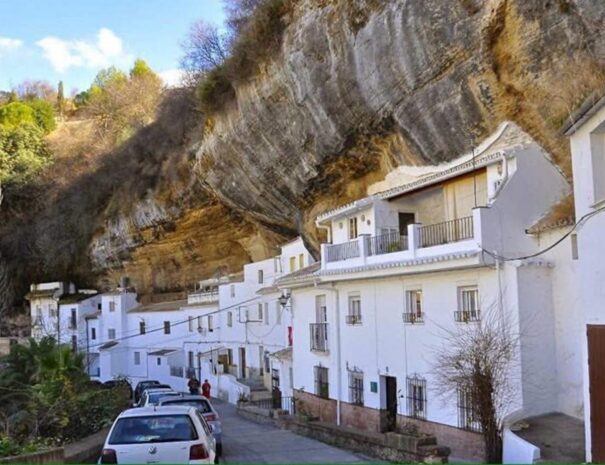
White villages in Spain
One of the best experiences to enjoy in Spain is to leave the big cities and get to know the small villages spread throughout Spain´s geography. The white villages in Spain is the most famous option. Located in Andalusia, southern Spain, these villages are located in fantastic landscapes and share white in their houses as a way to fight against the heat. In this guide we recommend you a road trip amongst some of the most beautiful white villages in Spain. … Read More
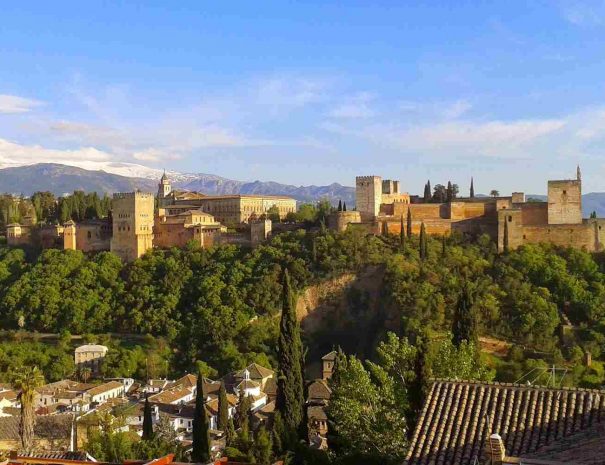
Granada City Guide
Granada is more than the iconic Alhambra. The sounds and scents at the Albaycin take you to a different world. Our local guides have curated a city guide of Granada with many recommendations to ensure you make the most out of your time here! … Read More
is proudly powered by WordPress

